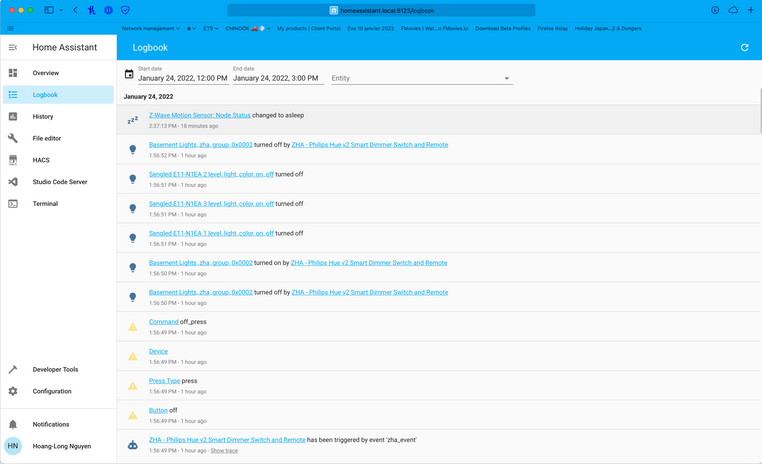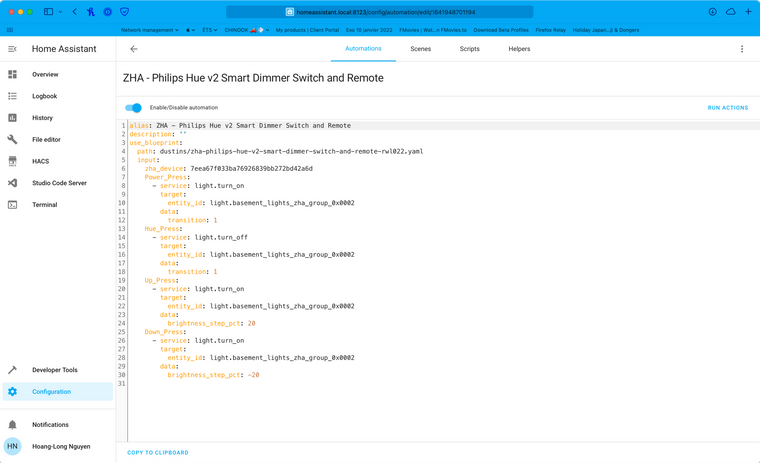Home Assistant
Integrating multiple smart home devices into a unified system using Home Assistant. This project eliminates the need for multiple apps by centralizing control through Apple HomeKit, automating lights, locks, and climate settings. It involves configuring integrations like Zigbee, Z-Wave, RTSP cameras, and APIs while optimizing automation for efficiency and convenience.
As part of my ongoing efforts to streamline and enhance my home automation setup, I designed and deployed a centralized smart home system using Home Assistant (HA). The goal was to integrate multiple smart home ecosystems into a single, unified platform, eliminating the need for separate brand-specific apps while improving automation, efficiency, and security.
System Architecture & Deployment
The foundation of the system is Home Assistant OS, running on a Raspberry Pi 4. The installation process involved: Flashing Home Assistant OS onto a microSD card and setting up the server; Installing essential utilities, including SSH server, VS Code Server, and HACS for custom integrations; Configuring remote access via Nabu Casa, enabling secure external control.
Device & Protocol Integration
A key challenge was integrating a diverse range of devices that operate on different communication protocols. I successfully unified the following:
-
Wi-Fi Devices: TP-Link Kasa, Tuya Smart Home, Blink, Mysa Thermostat.
-
Zigbee Devices: Configured via Zigbee Home Assistant (ZHA), forming a mesh network with routers and end devices.
-
Z-Wave Devices: Managed using Z-Wave JS, with secure S2-level inclusion for security devices.
-
RTSP Cameras: Configured by enabling RTSP streams in the web admin interface and setting up video encoding in ffmpeg.
-
eWeLink Smart Home: Integrated through HACS, requiring YAML configuration modifications.
-
Apple HomeKit: Home Assistant was recognized as a hub via a QR-code pairing process, bringing all devices into Apple’s Home app for centralized control.
Automation & Customization
Once all devices were integrated, I developed custom automations tailored to everyday scenarios. Using YAML scripting and HomeKit's automation engine, I created presence-based automations that automatically unlocked the door, turned on the lights, and adjusted the heating when I arrived home. When leaving, the system would lock the doors, turn off unnecessary devices, and lower the thermostat to conserve energy. Smart lighting and climate control automations further enhanced convenience by adjusting brightness and temperature based on time of day, motion detection, and external weather conditions. Security was another key focus, with cameras and sensors triggering alerts and recording events based on detected activity.
Technical Challenges & Key Learnings
This project required working with various technologies and protocols, leading to significant technical learning. Writing YAML configuration files became essential for setting up automations and device triggers. I also gained a deeper understanding of Z-Wave communication, particularly the two-way handshake authentication and secure inclusion process. Similarly, I explored the Zigbee ecosystem, learning how its mesh network architecture differentiates between routers and end devices to maintain a stable connection.
Additionally, I worked with APIs, specifically using Blinkpy for the Amazon Blink security camera integration, which provided insight into object-oriented programming (OOP) principles. Configuring IP cameras further expanded my knowledge of RTSP streaming, requiring me to adjust settings directly within the cameras' web interfaces to optimize performance. Finally, integrating the system with HomeKit provided valuable experience in bridging multiple ecosystems within a user-friendly platform.
TL;DR
I built a centralized smart home system using Home Assistant to unify multiple smart devices under one platform, eliminating the need for separate apps. Running on a Raspberry Pi 4, the system integrates Wi-Fi, Zigbee, Z-Wave, and RTSP cameras, with automations controlling lighting, security, and climate. I configured integrations like HomeKit, TP-Link Kasa, Tuya, Blink, and eWeLink, using YAML scripting, API interactions, and RTSP streaming. Through this project, I gained hands-on experience with IoT protocols, embedded automation, and smart home security, creating a scalable and efficient automation system.







